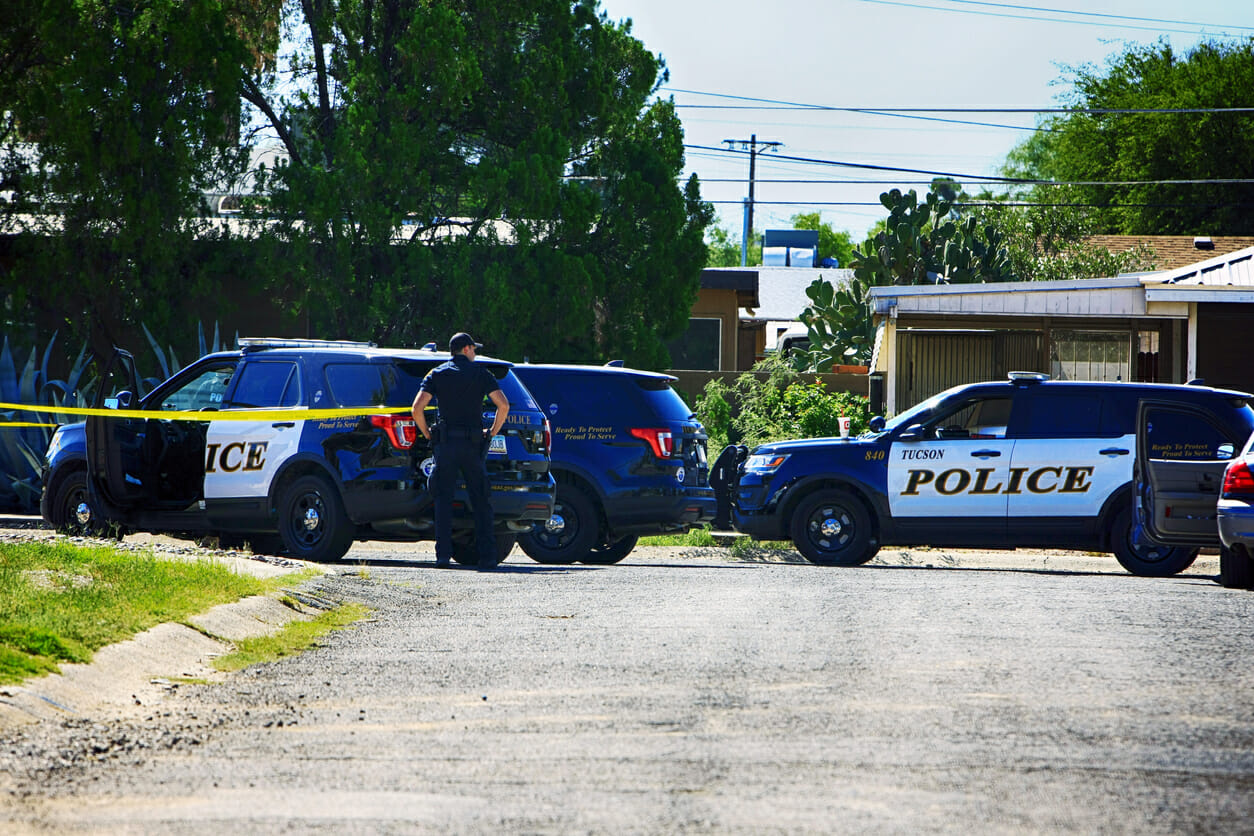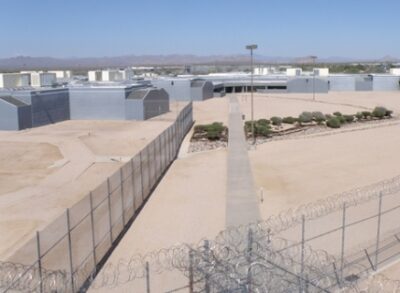
Criminal Justice in Arizona
Arizona’s criminal justice system has multiple branches. This article aims to summarize that system, highlight key data points, list critical statistical figures, and briefly comment on what works and what doesn’t in the Grand Canyon State.
Arizona Prison Population Statistics
When examining a state’s criminal justice system, one of the most critical questions is, “How many people are incarcerated?” Arizona has the fifth highest incarceration rate in the United States, behind Arkansas and ahead of Kentucky.1 According to 2019 data from the National Institute of Corrections, Arizona has 13,560 individuals spending time in jail awaiting trial or serving brief sentences for minor crimes.2 Arizona has 40,951 incarcerated inmates serving full sentences in state prisons.
Since the late-20th century, the rate of jailed individuals in Arizona has remained about the same. Meanwhile, the prison incarceration rate has soared. This means police officers are arresting and jailing about the same number of people per capita each year, but the percentage of arrested individuals who then become convicted and who then go on to serve prison sentences has gone up dramatically. For the hard data, Arizona’s prison population has increased by 507% since 1983.
As for its facilities, the State of Arizona maintains 22 jail centers and 14 state prisons. There are also six privately owned prisons in Arizona, four federal prisons, and two federal prison camps. While inmate numbers fluctuate from one facility to the next, the Florence State Prison usually houses the most inmates in the state, with some 3,500-3,900 inmates at any given time. Florence has been in operation since 1908. The Eyman facility, which has a much larger capacity than Florence, is a more recent addition to the state’s prison complex, built-in 1991.3
Crime Data and Recidivism Rates

Eyman, Florence State Prison. Courtesy of Corrections.az.gov
Arizona has an incarceration budget of $932,731,597, the 6th costliest budget item in the state, with more state funds being spent on incarceration than on healthcare and hospitals.4 The state has an incarceration rate of 558 inmates for every 100,000 people living in the state. The state’s violent crime rate is 455 per 100,000, suggesting that about one-fifth of Arizona’s inmates serve prison sentences for non-violent crimes. Arizona spends about $25,915 per inmate per year.
In 2020, Arizona law enforcement officers performed 10,885 arrests for violent crimes and 26,430 arrests for property crimes. Police officers performed thousands of other arrests that fall into other categories. Violent crimes account for 16% of Arizona’s total crime index, while property crimes account for 83% of the total crime index. In 2020, Arizona experienced a total of 423 murders, 2,838 rape offenses, 5,739 robberies, 19,751 cases of assault, and 26 cases of human trafficking. Total reported crimes came in at 28,777 for violent crimes and 149,901 for property crimes.5
Based on information gathered and published by the Bureau of Justice Assistance, Arizona’s criminal justice system has a recidivism rate of 42.4%, meaning close to half of those incarcerated in Arizona will experience incarceration again. Speaking honestly, that means Arizona’s approach to criminal justice and incarceration is not working for about half of those who go through the system.6
Recidivism is arguably the greatest drag on the efficacy and success of a state’s criminal justice system because it means the same individual will be incarcerated numerous times, requiring a multitude of state resources. While a 0% recidivism rate has not been achieved in any U.S. state yet, when a state like Arizona experiences a higher-than-average recidivism rate, it signals the need for better programs. More effective approaches to criminal rehabilitation would reduce the toll of incarceration on the state’s budget and on the people of the state.
Criminal Rehabilitation in Arizona and Effective Policy
Programs are being utilized within the criminal justice system in Arizona that are helping rehabilitate inmates. For example, in 2008, Arizona became the first state to implement a performance-based adult probation system. Under this system, probation departments are awarded a share of the state’s savings if those departments are successful in reducing local recidivism amongst paroled individuals. Then the department can spend the returned savings on further improving their department and further reducing recidivism.7
In 2021, Arizona Governor Ducey signed three bills into law that will hopefully offer more effective criminal rehabilitation in Arizona and a better approach to criminal justice policy. They are summarized as follows:

- House Bill 2318 will give prosecutors and judges more flexibility in their procedures. Doing so will ensure that first-time offenders don’t receive disproportionately high sentences (first-time offenders convicted of low-level crimes who are then exposed to long sentences might be worse off after that sentence than before they arrived in prison).
- House Bill 2319 changes the law so that previously convicted offenders can no longer be denied an occupational license as long as they are qualified applicants for that license and as long as their only conviction was a drug offense. This bill aims to make it easier for rehabilitated offenders to rejoin the workforce and seek gainful employment.
- House Bill 2166 was designed to reform Arizona’s criminal justice policy and hopefully troubleshoot the state’s high recidivism rate by creating a new policy body, the Arizona Criminal Justice Commission.
Many of these rehabilitation programs and policy efforts are recent, so their efficacy is still being measured, but the goal is that they will improve how criminal justice is performed in Arizona.
A Need for Alternatives to Incarceration in Arizona
Some alternative-to-incarceration programs are already in place in Arizona, though the state should significantly expand them. One example is the city of Tucson’s Mental Health Division’s Diversion Program. This program originated from the recognition that forcing mentally ill offenders to spend extensive periods in jail or prison for non-violent crimes is counterproductive. The Mental Health Division’s Diversion Program sought to reduce offender jail time from 22 days to eight days, as long as offenders sought help at a qualified treatment center afterward.
After the program’s initial success was apparent during a 1999 to 2003 trial period, Tucson expanded the program to include non-violent crimes connected to prostitution and/or substance abuse. Again the program was found to be successful. Quoting one report, “Participation in the Mental Health Division’s Diversion program has also reduced the occurrence of new offenses and additional days spent in jail by mentally ill defendants. 90% of defendants entering Diversion complete the program by continuing their mental health treatment plan and avoiding additional criminal charges.”8
In addition to programs like Tucson’s Mental Health Division’s Diversion Program, the state of Arizona employs an array of drug court programs. The state manages 59 such programs, each tasked with helping drug-related offenders avoid hard prison sentences and instead seek treatment for substance abuse problems. However, Arizona law enforcement officers perform close to 20,000 drug-related arrests every year (possession arrests, not arrests for the sale of drugs). That means Arizona’s 59 drug court programs are immensely overburdened in their efforts to ensure all arrested individuals receive substance treatment services rather than heavy prison sentences.
If programs like Tucson’s diversion program and the state’s drug court programs could be set up in every urban area in Arizona, they would almost certainly succeed in lowering state-wide recidivism and the tax burden of Arizona’s criminal justice and incarceration system.
Criminal Reform in Arizona Can Be Attained
Arizona’s criminal justice system has gotten some things right, but there is room for improvement. Sadly, the state spends close to (and sometimes more than) $1 billion on its criminal justice system each year, with an almost 50% recidivism rate.
“The criminal justice system consumes a large and increasing share of our tax dollars. These dollars should be used wisely and in ways that protect public safety.”
Arizonans are aware of the problem and want change. Thankfully, elected officials are listening. Quoting a 2018 Arizona Town Hall report by elected leaders, “The criminal justice system consumes a large and increasing share of our tax dollars. These dollars should be used wisely and in ways that protect public safety. We need to start asking such hard questions with the realization that asking such hard questions is not being ‘soft on crime.’ Asking hard questions and demanding evidence-based answers can protect both the public’s pocket book and its safety – on our streets, in our courtrooms, in our jails and prisons and in our communities.” That statement alone makes it clear that Arizonans from all walks of life; laypersons, political leaders, policymakers, and others are aware of the problem and willing to tackle it. The next step will be brainstorming solutions.9
Thankfully, effective tools for criminal reform do exist. Alternatives to prison have been developed that work such as educational programs inside prisons which have proven to be effective in reducing recidivism. Launching evidence-based rehabilitation programs inside Arizona prisons may be the key that residents have been looking for to improve how the state addresses and overcomes the difficult problem of crime and punishment.10
Sources:
- BJS. “Prisoners in 2020 – Statistical Tables.” Bureau of Justice Statistics, 2020. bjs.ojp.gov
- NIC. “Arizona 2019.” National Institute of Corrections, 2019. nicic.gov
- ADCRR. “Florence.” Arizona Department of Corrections, 2022. corrections.az.gov
- Urban Institute. “Project Arizona.” Urban Institute, 2022. urban.org
- AZDPS. “Crime in Arizona 2020.” Arizona Department of Public Safety. 2021. azdps.gov
- BJA. “State Criminal Justice Profile, Arizona.” Bureau of Justice Assistance, 2014. bjafactsheets.iir.com
- SB 1476. “Probation; Facilities; Safe Communities Act.” Arizona Legislature, 2008. azleg.org
- The City of Tucson. “Alternatives to Incarceration.” City of Tucson, 2004. tucsonaz.gov
- Arizona Town Hall. “Criminal Justice in Arizona.” Arizona Town Hall, 2018. aztownhall.org
- LEAD. “Law Enforcement Assisted Diversion.” LEAD, 2022. leadkingcounty.org
Related Articles
Criminal Justice Reform Extends Rights to Felons Who Have Served Their Sentences
For decades, voter enfranchisement or disenfranchisement for incarcerated and formerly incarcerated individuals has been debated. An estimated 4.6 million Americans are barred from voting due...
Read more >>
What Is the Scope of Private Prisons in the U.S.?
In 2001, the Federal Bureau of Justice Assistance authored a report analyzing then-emergent issues regarding private prisons in the United States. According to the authors...
Read more >>
What Can We Do to Ensure the Formerly Incarcerated Do Not Return to Crime?
According to the Bureau of Justice Statistics, two out of three formerly incarcerated people in the U.S. commit another crime within three years of release....
Read more >>
Student Success in California Correctional Facilities
"I am a firm believer that each and every one of us has a light source within us and it is up to us how...
Read more >>





